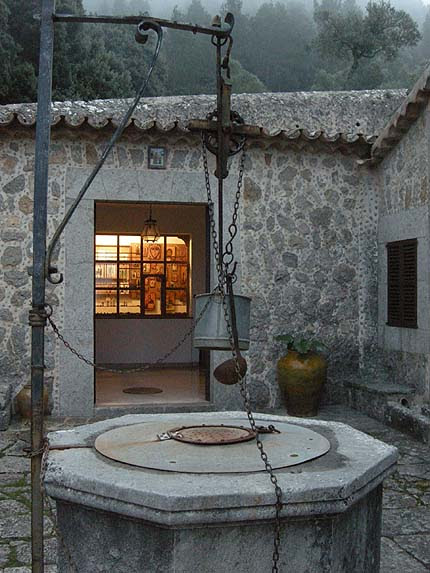

By “the hermit of Valldemossa” they usually intend Chopin who between November 1838 and February 1839 spent an in every respect turbulent winter with George Sand in the Charterhouse of Valldemossa, converted into an inn just some years earlier. Sand in her
A winter in Mallorca writes in detail not only about the beauty of the island, but also about their miserable circumstances and the suspicion of the conservative Mallorcans towards the strangers that came from Paris, while at the same time this was one of the most fertile periods in Chopin’s life. The tourists visiting today the former
cell of the couple do not know that less than three kilometers from here there is a still vivid medieval hermitage standing on the steep rocks of the seashore.





The hermitage, named after the Trinity, is rather just visited by the people from the neighborhood on Sunday mornings, when a Mass is held in the chapel. It was in the summer that we came here for the first time, and I watched in surprise that the families coming out of the church, instead of descending on the rocky path, scattered about the clearing, fires were lit, they took out the huge round tins and each started to prepare his own paella. On this murky winter evening, however, no one was upstairs at the hermitage.



The tradition of the hermitage has been living here since the 13th century when Raimundus Lullus, converted into a hermit from a troubadour and royal seneschal, with the support of King Jaume II founded the school of Oriental languages in the neighboring Miramar. From then on, this rocky and wooded coastline is called “Desert de la Trinitat”, “the hermitage of the Trinity”.




The heyday of the hermitage was in the 17th century, when the venerable Joan Mir de la Concepció in 1646, not far from here, on the site of a former hermitage founded his convent named after the Egyptian hermit fathers Saint Paul and Anthony. It was him who also founded the today existing building of the Ermita de la Trinitat in 1648. The chapel was built in 1703 on the foundations of a former one.



The ruins of Joan Mir’s first “old hermitage” are still visible today in the woods, between oak trees and lime-kilns. Not far away, next to a cave an inscription from 1627 proclaims that it was the hermit’s cave of Raimundus Lullus who offered here all his works to the Holy Virgin. And from there the trail soon reaches Miramar where the great researcher of 19th-century Mallorca, the Hapsburg Archduke
Luis Salvador de Austria built himself a modern hermitage on the seashore.


5 comentarios:
I wish I were there, at that magical hour. Thank you for those great photos. I was always trying to imagine that place.
I wish you were here at that magical hour. Sure it would have touched you and you could have rendered it in a very evocative way on paper or canvas.
thank you for the winter monastery.. the icons through the window look Byzantine (Orthodox) ?
It reminds me of the monastery of Galataki on Evia. Built by the Byzantines on the site of a ruined temple to Poseidon, raided repeatedly by Venetian pirates during the Turkish occupation until finally destroyed: then rebuilt last century and now a nunnery. The goats wander the olive groves now, with a gentle clonking of bells. A statue of Poseidon was retrieved from the deeps below the cliff of Mt. Kandili nearby; the locals tell me that the town of Aigai where Poseidon's palace lay in the depths, was here by this site.
Thank you for the reference and impressive photo (is it yours?) of Galataki. What a beautiful and peaceful place! It has much in common with the atmosphere of the Ermita in Mallorca. Even the gentle clonking of bells of the sheep wandering the olive groves is so characteristic of the Mallorcan landscape.
Yes, the icons follow the Orthodox ones: they are quite a fashion nowadays in the Catholic church as well. These ones have been painted by one of the hermits, and occasionally purchased by the people coming to the Mass on Sunday morning or visiting the chapel.
not my picture unfortunately, I could not find mine.. my father-in-law is from Limni, just down the road. One summer I used to run from town up past the monastery and back, on most evenings. It was a beautiful <a href="http://dkretzmann.blogspot.com/2008/08/on-kandili.html>run</a>.
Publicar un comentario